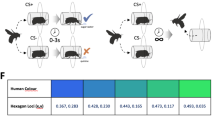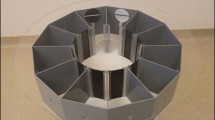Abstract
Animals react to salient stimuli via unconditioned responses, Pavlovian conditioning, conditioned manipulation of objects in simple and complex ways (instrumental/operant learning and tool use) and insight learning. Bumblebees are known to learn to manipulate natural and artificial complex flowers to obtain rewards. Even though those tasks involve instrumental learning, all have been rather natural, resembling activities that bees would perform living free in the wild. None have involved the generation of more unnatural, arbitrary responses (true operants) such as detour behaviour; in which subjects have to gain a completely hidden, covered reward by moving objects away from it by multiple body lengths. Furthermore, few have involved discriminative stimuli, wherein subjects learn that the appropriate way to perform an operant is signalled by specific cues. We therefore trained bumblebees with two types of task that we believe represented challenges unlike any they have evolved to respond to. These involved dragging various-sized caps aside and rotating discs through varying arcs away from the entrances of artificial flowers (via detours of up to three body lengths), to access a reward hidden beneath. Further, we successfully trained bees to use disc colour as a discriminative stimulus predicting whether rotating discs clockwise or counterclockwise would reveal the reward. This true, complex operant conditioning demonstrated that bumblebees can learn novel, arbitrary behavioural sequences, manipulating and moving items in ways that seem far from any natural task that they would encounter, and doing so flexibly in response to specific discriminative stimuli. This adds to growing evidence of impressive behavioural plasticity and learning abilities in bees, and suggests new approaches for probing their cognitive abilities in the future.









Similar content being viewed by others
References
Abramson CI, Feinman RD (1990) Lever-press conditioning in the crab. Physiol Behav 48:267–272
Avarguès-Weber A, Dyer AG, Giurfa M (2011) Conceptualization of above and below relationships by an insect. Proc R Soc B-Biol Sci 278:898–905
Avarguès-Weber A, Dyer AG, Combe M, Giurfa M (2012) Simultaneous mastering of two abstract concepts by the miniature brain of bees. Proc Nat Acad Sci (USA) 109:7481–7486
Brembs B (2000) The operant and the classical in conditioned orientation of Drosophila melanogaster at the flight simulator. Learn Mem 7:104–115
Brembs B (2003) Operant conditioning in invertebrates. Curr Opin Neurol 13:710–717
Chittka L (1998) Sensorimotor learning in bumblebees: long-term retention and reversal training. J Exp Biol 201:515–524
Chittka L, Thomson JD (eds) (2005) Cognitive ecology of pollination. In: Animal behavior and floral evolution. Cambridge University Press, Cambridge
Chittka L, Dyer AG, Bock F, Dornhaus A (2003) Bees trade off foraging speed for accuracy. Nature 424:388
Chittka L, Ings TC, Raine NE (2004) Chance and adaptation in the evolution of island bumblebee behaviour. Popul Ecol 46:243–251
Collett TS, Fry SN, Wehner R (1993) Sequence learning by honeybees. J Comp Physiol A 172:693–706
D’Amato MR (1991) Comparative cognition: processing of serial order and serial pattern. In: Dachowski L, Flaherty CF (eds) Current topics in animal cognition: brain, emotion, and cognition. Erlbaum, Hillsdale, pp 165–185
D’Amato MR, Colombo M (1988) Representation of serial order in monkeys (Cebus apella). J Exp Psych Anim Behav Process 14:131–139
Darwin C (1877) The various contrivances by which orchids are fertilized by insects, 2d edn. D. Appleton, New York
Delaney PF, Reder LM, Staszewski JJ, Ritter FE (1998) The strategy specific nature of improvement: the power law applies by strategy within task. Psychol Sci 9:1–8
Gegear RJ, Laverty TM (1995) Effect of flower complexity on relearning flower-handling skills in bumble bees. Can J Zool Rev Can Zool 73:2052–2058
Gegear RJ, Laverty TM (2005) Flower constancy in bumblebees: a test of the trait variability hypothesis. Anim Behav 69:939–949
Giurfa M, Zhang S, Jenett A, Menzel R, Srinivasan MV (2001) The concepts of ‘sameness’ and ‘difference’ in an insect. Nature 410:930–933
Gong ZF, Xia S, Feng C, Guo A (1998) Operant visual learning and memory in Drosophila mutants dunce, amnesiac and radish. J Insect Physiol 44:1149–1158
Grau JW (2014) Learning from the spinal cord: how the study of spinal cord plasticity informs our view of learning. Neurobiol Learn Mem 108:155–171
Heathcote A, Brown S, Mewhort DJK (2000) The power law repealed: the case for an exponential law of practice. Psychol Bull Rev 7:185–207
Jandt JM, Bengston S, Pinter-Wollman N, Pruitt J, Raine NE, Dornhaus A, Sih A (2014) Behavioral syndromes and social insects: personality at multiple levels. Biol Rev 89:48–67
Jeanson R, Weidenmüller A (2014) Interindividual variability in social insects—proximate causes and ultimate consequences. Biol Rev 89:671–687
Keasar T, Motro U, Shur Y, Shmida A (1996) Overnight memory retention of foraging skills by bumblebees is imperfect. Anim Behav 52:95–104
Kisch J, Erber J (1999) Operant conditioning of antennal movements in the honey bee. Behav Brain Res 99:93–102
Laverty TM (1980) The flower-visiting behaviour of bumble bees—floral complexity and learning. Can J Zool Rev Can Zool 58:1324–1335
Laverty TM, Plowright RC (1988) Flower handling by bumble bees—a comparison of specialists and generalists. Anim Behav 36:733–740
Mirwan HB, Kevan PG (2013) Social learning in bumblebees (Bombus impatiens): Worker bumblebees learn to manipulate and forage at artificial flowers by observation and communication within the colony. Psyche 2013:768108-1–768108-8. doi:10.1155/2013/768108
Mirwan HB, Kevan PG (2014) Problem solving by worker bumblebees Bombus impatiens (Hymenoptera: Apoidea). Anim Cogn. doi:10.1007/s10071-014-0737-0
Mirwan HB, Kevan PG (2015) Maze learning and route memorization by worker bumblebees Bombus impatiens (Cresson) (Hymenoptera: Apidae). J Insect Behav 28:345–357
Newell A, Rosenbloom PS (1981) Mechanisms of skill acquisition and the law of practice. In: Anderson JR (ed) Cognitive skills and their acquisition. Erlbaum, Hillsdale, pp 1–55
NIOSH (2010) Sucrose. NIOSH pocket guide to chemical hazards. National Institute for Occupational Safety and Health USA. http://www.cdc.gov/niosh/npg/npgd0574.html. Accessed 13 Feb 2014
Pearce JM (2008) Animal learning and cognition. An introduction (3rd ed.). Psychology Press, Hove, UK
Pessotti I (1972) Discrimination with light stimulus and a lever-pressing response in Melipona rufiventris. J Apic Res 11:89–93
Raine NE, Chittka L (2007) Pollen foraging: learning a complex motor skill by bumblebees (Bombus terrestris). Naturwissenschaften 94:459–464
Regolin L, Vallortigara G, Zanforlin M (1995) Detour behaviour in the domestic chick: searching for a disappearing prey or a disappearing social partner. Anim Behav 50:203–211
Rubadeau DO, Conrad KO (1963) An apparatus to demonstrate and measure operant behaviour of Arthropoda. J Exp Anal Behav 6:429–430
Sanz C, Call J, Boesch C (2013) Tool use in animals: cognition and ecology. Cambridge University Press, Cambridge
Schwarz R (1955) Uber die Riechschärfe der Honigbiene. Z Vergleich Physiol 37:180–210
Shettleworth SJ (1998) Cognition, evolution, and behavior. Oxford University Press, Oxford
Shumaker RW, Walkup KR, Beck BB (2011) Animal tool behavior: the use and manufacture of tools by animals. The Johns Hopkins University Press, Baltimore
Skinner BF (1938) The behavior of organisms: an experimental analysis. Appleton-Century- Crofts, New York
Sokolowski MBC, Disma G, Abramson CI (2010) A paradigm for operant conditioning in blow flies (Phormia terrae novae Robineau-Desvoidy 1830). J Exp Anal Behav 93:81–89
Staddon JER, Cerutti DT (2003) Operant conditioning. Ann Rev Psychol 54:115–144
Tarsitano M (2006) Route selection by a jumping spider (Portia labiata) during the locomotory phase of a detour. Anim Behav 72:1437–1442
Tarsitano MS, Jackson RR (1994) Jumping spiders make predatory detours requiring movement away from prey. Behaviour 131:65–73
Tomina Y, Takahata M (2010) A behavioral analysis of force-controlled operant tasks in American lobster. Physiol Behav 101:108–116
von Frisch K (1967) The dance language and orientation of bees. Belknap Press, Cambridge
Wells MJ (1964) Detour experiments with octopuses. J Exp Biol 41:621–642
Wustmann G, Wustmann G, Rein K, Wolf R, Heisenberg M (1996) A new paradigm for operant conditioning of Drosophila melanogaster. J Comp Physiol A Neuroethol Sens Neural Behav Physiol 179:429–436
Zucca P, Antonelli F, Vallortigara G (2005) Detour behaviour in three species of birds: quails (Coturnix sp.), herring gulls (Larus cachinnans) and canaries (Serinus canaria). Anim Cogn 8:122–128
Acknowledgments
We thank the Canadian Pollination Initiative (NSERC-CANPOLIN) for funding some of this research reported. This contribution is No. 136 from NSERC-CANPOLIN. HM thanks the Libyan Ministry of Education and Canadian Bureau for International Students for scholarships received. BioBest Biological Systems, Leamington, ON, Canada kindly provided colonies of the test subjects. GJM thanks NSERC for funding her Canada Research Chair.
Author information
Authors and Affiliations
Corresponding author
Rights and permissions
About this article
Cite this article
Mirwan, H.B., Mason, G.J. & Kevan, P.G. Complex operant learning by worker bumblebees (Bombus impatiens): detour behaviour and use of colours as discriminative stimuli. Insect. Soc. 62, 365–377 (2015). https://doi.org/10.1007/s00040-015-0414-6
Received:
Revised:
Accepted:
Published:
Issue Date:
DOI: https://doi.org/10.1007/s00040-015-0414-6




